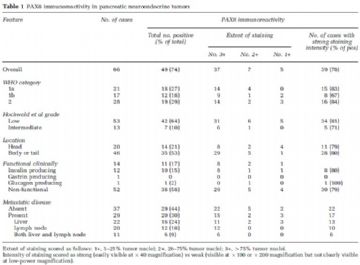| 图片: | |
|---|---|
| 名称: | |
| 描述: | |
- 病例学习(Number 11)
| 姓 名: | ××× | 性别: | 年龄: | ||
| 标本名称: | |||||
| 简要病史: | |||||
| 肉眼检查: | |||||
因为治疗的差别:(对temozolimide-based therapies的敏感性不同)有必要鉴别。
PAX8 expression reliably distinguishes pancreatic well-differentiated neuroendocrine tumors from ileal and
pulmonary well-differentiated neuroendocrine tumors and pancreatic acinar cell carcinoma
Modern Pathology (2011) 24, 412–424;
PAX (paired box) genes encode a family of transcription factors that regulate organogenesis in a variety of
organs. Very little is known about the role of PAX8 in endocrine cell development and the expression of PAX8 in
neuroendocrine tumors. The purpose of this study was to analyze PAX8 immunohistochemical expression in
gastroenteropancreatic and pulmonary well-differentiated neuroendocrine tumors to determine whether PAX8
can reliably distinguish pancreatic neuroendocrine tumors from neuroendocrine tumors of other anatomic sites
and other pancreatic non-ductal neoplasms. In total, 221 well-differentiated neuroendocrine tumors were
evaluated: 174 primary neuroendocrine tumors (66 pancreatic, 31 ileal, 21 pulmonary, 20 gastric, 17 rectal,
11 appendiceal, and 8 duodenal) and 47 neuroendocrine tumors metastatic to the liver (31 pancreatic, 11 ileal,
2 pulmonary, 2 duodenal, and 1 rectal). Fifteen solid-pseudopapillary neoplasms and six acinar cell carcinomas
of the pancreas were also evaluated. PAX8 was positive in 49/66 (74%) primary pancreatic neuroendocrine
tumors. PAX8 expression did not correlate with World Health Organization categorization, grade, size, functional
status, or the presence of liver or lymph node metastasis. PAX8 expression was identified in 0/31 (0%) ileal,
0/21 (0%) pulmonary, 2/20 (10%) gastric, 5/17 (29%) rectal, 1/11 (9%) appendiceal, and 6/8 (75%) duodenal
neuroendocrine tumors. PAX8 was positive in 4/15 (27%) solid-pseudopapillary neoplasms of the pancreas,
whereas all acinar cell carcinomas (0/6) lacked immunoreactivity. Among liver metastases, only pancreatic
neuroendocrine tumors (20/31, 65%) were PAX8 positive, whereas no cases of ileal (0/11), pulmonary (0/2),
duodenal (0/2), and rectal (0/1) neuroendocrine tumor metastases were PAX8 positive. PAX8 is expressed in
primary and metastatic pancreatic well-differentiated neuroendocrine tumors, and its expression can reliably
distinguish pancreatic from ileal and pulmonary well-differentiated neuroendocrine tumors. Duodenal
neuroendocrine tumors and a subset of rectal, gastric, and appendiceal neuroendocrine tumors may also
express PAX8. PAX8 expression can distinguish pancreatic neuroendocrine tumors from acinar cell carcinomas,
but its utility in distinguishing neuroendocrine tumors from solid-pseudopapillary neoplasms is limited.


















